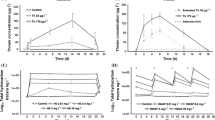Abstract
The relationship between organisms and contaminants may be a two-way interaction: contaminants affecting the biota and the biota affecting the environmental fate and distribution of the contaminants. This may be especially so for sediment-dwelling organisms, because their burrowing and feeding can drastically influence sediment characteristics. The present study looked at the influence of the suspension-feeding stout razor clam Tagelus plebeius on the distribution of crude oil and pyrene in greenhouse mesocosm experiments. Water column turbidity and sediment redox also were monitored during the 15- to 30-day exposures to provide information on the influence of hydrocarbons and the razor clams on environmental conditions. For the experiment with crude oil, sediment was taken from the mesocosms at the end of the experiment, and the hydrocarbon-degradation potential was assessed in incubations with 14C-naphthalene. The experiments used four treatments: hydrocarbons present/absent and razor clams present/absent. Hydrocarbon dosing levels were relatively low (1 mL of oil or 30 mg of pyrene per mesocosm with 22 L of natural sediment and 11 L of seawater). The presence of the razor clams resulted in hydrocarbon concentrations at the sediment surface being 25% lower than in mesocosms without clams. No consistent effects were noted for polycyclic aromatic hydrocarbon (PAH) concentrations in the water column or in subsurface sediment. The naphthalene-degradation potential was elevated for sediment from mesocosms dosed with oil, but the presence of the clams did not affect this potential. The presence of the razor clams resulted in a lowering of water column turbidity, but no effect on sediment redox. The hydrocarbon addition had no effect on turbidity, but sediment redox was lowered. While results show that the presence of the razor clams resulted in a loss of hydrocarbons from the surface sediment, the other results do not provide a clear picture of the underlying mechanisms and the fate of the PAHs lost from the sediment surface. We hypothesize that the loss of surface sediment PAHs was due to burial of surface sediment and possibly bioaccumulation by the clams. While additional research is needed for further insights into underlying mechanisms, the present work demonstrates that the presence of sediment-burrowing suspension feeders decreases hydrocarbon levels in surface sediment. This means that assessments of the impact of an oil spill should pay attention to effects on these organisms and to their influence on the fate and distribution of the spilled oil.






Similar content being viewed by others
References
Aller RC, Yingst JY (1985) Effects of the marine deposit-feeders Heteromastus filiformis (Polychaeta), Macoma balthica (Bivalvia), and Tellina texana (Bivalvia) on averaged sedimentary solute transport, reaction rates, and microbial distributions. J Mar Res 43:615–645
Alvarez MF, Addino M, Iribarne O, Botto F (2015) Combined engineering effects of clams and crabs on infaunal assemblages and food availability in intertidal systems. Mar Ecol Prog Ser 540:57–71
Arruda EP, Domaneschi O, Amaral ACZ (2003) Mollusc feeding guilds on sandy beaches in São Paula State, Brazil. Mar Biol 143:691–701
Blankson ER, Klerks PL (2016a) The effect of bioturbation by Lumbriculus variegatus on transport and distribution of lead in a freshwater microcosm. Environ Toxicol Chem 35:1123–1129
Blankson ER, Klerks PL (2016b) The effect of lead from sediment bioturbation by Lumbriculus variegatus on Daphnia magna in the water column. Ecotoxicology 25:1712–1719
Camus L, Birkely SR, Jones MB, Børseth JF, Grøsik BE, Gulliksen B, Lønne OJ, Regoli F, Depledge MH (2003) Biomarker responses and PAH uptake in Mya truncata following exposure to oil-contaminated sediment in an Arctic fjord (Svalbard). Sci Total Environ 308:221–234
Castagna M, Chanley P (1973) Salinity tolerance of some bivalves from inshore and estuarine environments in Virginia waters on the western mid-Atlantic coast. Malacologia 12:47–96
Chung WK, King GM (1999) Biogeochemical transformations and potential polyaromatic hydrocarbon degradation in macrofaunal burrow sediments. Aquat Microbiol Ecol 19:285–295
Chung WK, King GM (2001) Isolation, characterization, and polyaromatic hydrocarbon degradation potential of aerobic bacteria from marine macrofaunal burrow sediments and description of Lutibacterium anuloederans gen. nov., sp. nov., and Cycloclasticus spirillensus sp. nov. Appl Environ Microbiol 67:5585–5592
Ciarelli S, Van Straalen NM, Klap VA, Van Wezel AP (1999) Effects of sediment bioturbation by the estuarine amphipod Corophium volutator on fluoranthene resuspension and transfer into the mussel (Mytilus edulis). Environ Toxicol Chem 18:318–328
Ciutat A, Anschutz P, Gerino M, Boudou A (2005) Effects of bioturbation on cadmium transfer and distribution into freshwater sediments. Environ Toxicol Chem 24:1048–1058
Colin PL, Suchanek TH, McMurtry GM (1986) Water pumping and particulate resuspension by callianassids (Crustacea: Thalassinidea) at Enewetak and Bikini Atolls, Marshall Islands. Bull Mar Sci 38:19–24
Gunnarsson JS, Hollertz K, Rosenberg R (1999) Effects of organic enrichment and burrowing activity of the polychaete Nereis diversicolor on the fate of tetrachlorobiphenyl in marine sediments. Environ Toxicol Chem 18:1149–1156
Gutiérrez JL, Iribarne OO (2004) Conditional responses of organisms to habitat structure: an example from intertidal mudflats. Oecologia 139:572–582
Hastings DW, Schwing PT, Brooks GR, Larson RA, Morford JL, Roeder T, Quinn KA, Bartlett T, Romero IC, Hollander DJ (2016) Changes in sediment redox conditions following the BP DWH blowout event. Deep-Sea Res II 129:167–178
Hazen TC, Dubinsky EA, DeSantis TZ, Andersen GL, Piceno YM, Singh N, Jansson JK, Probst A, Borglin SE, Fortney JL et al (2010) Deep-sea oil plume enriches indigenous oil-degrading bacteria. Science 330:204–208
Holland AF, Dean JM (1977) The biology of the stout razor clam Tagelus plebeius: I. Animal–sediment relationships, feeding mechanism, and community biology. Chesap Sci 18:58–66
Joye SB (2015) Deepwater Horizon, 5 years on. Science 349:592–593
Katrak G, Bird FL (2003) Comparative effects of the large bioturbators, Trypaea australiensis and Heloecius cordiformis, on intertidal sediments of Western Port, Victoria, Australia. Mar Freshw Res 54:701–708
Kleindienst S, Seidel M, Ziervogel K et al (2015) Chemical dispersants can suppress the activity of natural oil-degrading microorganisms. Proc Natl Acad Sci USA 112:14900–14905
Klerks P, Fraleigh P, Lawniczak J (1997) Effects of the exotic zebra mussel (Dreissena polymorpha) on metal cycling in Lake Erie. Can J Fish Aquat Sci 54:1630–1638
Klerks PL, Felder DL, Strasser KM, Swarzenski PW (2007) Effects of ghost shrimp on zinc and cadmium in sediments from Tampa Bay, FL. Mar Chem 104:17–26. https://doi.org/10.1016/j.marchem.2006.12.014
Langston WJ, O’Hara S, Pope ND, D’avey M, Shortridge E, Imamura M, Harino H, Kim A, Vane CH (2012) Bioaccumulation surveillance in Milford Haven Waterway. Environ Monit Assess 184:289–311
Linville RG, Luoma SN, Cutter L, Cutter GA (2002) Increased selenium threat as a result of invasion of the exotic bivalve Potamocorbula amurensis into the San Francisco Bay-Delta. Aquat Toxicol 57:51–64
Liu Y, Kujawinski EB (2015) Chemical composition and potential environmental impacts of water-soluble polar crude oil components inferred from ESI FT-ICR MS. PLoS ONE 10:e0136376. https://doi.org/10.1371/journal.pone.0136376
Martin JB, Cable JE, Jaeger J, Hartl K, Smith CG (2006) Thermal and chemical evidence for rapid water exchange across the sediment-water interface by bioirrigation in the Indian River Lagoon, Florida. Limnol Oceanogr 51:1332–1341
McMurtry GM, Schneider RC, Colin PL, Buddemeier RW, Suchanek TH (1986) Vertical distribution of fallout radionuclides in Enewetak lagoon sediments: effects of burial and bioturbation on the radionuclide inventory. Bull Mar Sci 38:35–55
Menon NN, Menon NR (1999) Uptake of polycyclic aromatic hydrocarbons from suspended oil borne sediments by the marine bivalve Sunetta scripta. Aquat Toxicol 45:63–69
Nates SF, Felder DF (1998) Impacts of burrowing ghost shrimp, genus Lepidophthalmus Crustacea: Decapoda: Thalassinididea, on penaeid shrimp culture. J World Aquacult Soc 29:188–210
Papaspyrou S, Gregersen T, Cox RP, Thessalou-Legaki M, Kristensen E (2005) Sediment properties and bacterial community in burrows of the ghost shrimp Pestarella tyrrhena (Decapoda: Thalassinidae). Aquat Microbiol Ecol 38:181–190
Passow U (2016) Formation of rapidly-sinking, oil-associated marine snow. Deep-Sea Res II 129:232–240
Qin X, Sun H, Wang C, Yu Y, Sun T (2010) Impacts of crab bioturbation on the fate of polycyclic aromatic hydrocarbons in sediment from the Beitang estuary of Tianjin, China. Environ Toxicol Chem 29:1248–1255
Remaili TM, Simpson SL, Amato ED, Spadaro DA, Jarolimek CV, Jolley DF (2016) The impact of sediment bioturbation by secondary organisms on metal bioavailability, bioaccumulation and toxicity to target organisms in benthic bioassays: implications for sediment quality assessment. Environ Pollut 208:590–599
Schaller J (2014) Bioturbation/bioirrigation by Chironomus plumosus as main factor controlling elemental remobilization from aquatic sediments? Chemosphere 107:336–343
Sizmur T, Canário J, Edmonds S, Godfrey A, O’Driscoll NJ (2013) The polychaete worm Nereis diversicolor increases mercury lability and methylation in intertidal mudflats. Environ Toxicol Chem 32:1888–1895
Stauffert M, Cravo-Laureau C, Jézéquel R, Barantal S, Cuny P, Gilbert F, Cagnon C, Militon C, Amouroux D, Mahdaoui F et al (2013) Impact of oil on bacterial community structure in bioturbated sediments. PLoS ONE 8:e65347. https://doi.org/10.1371/journal.pone.0065347
Urban-Malinga B, Zalewski M, Barnes N (2016) Effects of various bivalves on meiobenthic and nematode assemblages in shallow sandy sediments. Hydrobiologia 772:131–144
Yang T, Speare K, McKay L, MacGregor BJ, Joye SB, Teske A (2016) Distinct bacterial communities in surficial seafloor sediments following the 2010 Deepwater Horizon blowout. Front Microbiol 7:1384
Zuijdgeest A, Huettel M (2012) Dispersants as used in response to the MC252-spill lead to higher mobility of polycyclic aromatic hydrocarbons in oil-contaminated Gulf of Mexico sands. PLoS ONE 7:e50549. https://doi.org/10.1371/journal.pone.0050549
Acknowledgements
The authors greatly appreciate the assistance provided by William Anderson, Emmanuel Blankson, Jessica Ector, Fatima Fazal-ur-Rehman, Marco Franco, Marie Hoag, Frank Higgins, Simon Pecknik, Mohammed Gazzaz, and Taylor Terracina. This research was made possible by Grant GoMRI-025 from The Gulf of Mexico Research Initiative. Data are publicly available through the Gulf of Mexico Research Initiative Information & Data Cooperative (GRIIDC) at https://data.gulfresearchinitiative.org (DOIs https://doi.org/10.7266/n7w093ws, https://doi.org/10.7266/N7MK69WH, https://doi.org/10.7266/N7GT5K6N and https://doi.org/10.7266/N7DV1H8X).
Author information
Authors and Affiliations
Corresponding author
Electronic supplementary material
Below is the link to the electronic supplementary material.
Rights and permissions
About this article
Cite this article
Klerks, P.L., Kascak, A., Cazan, A.M. et al. Effects of the Razor Clam Tagelus plebeius on the Fate of Petroleum Hydrocarbons: A Mesocosm Experiment. Arch Environ Contam Toxicol 75, 306–315 (2018). https://doi.org/10.1007/s00244-018-0515-0
Received:
Accepted:
Published:
Issue Date:
DOI: https://doi.org/10.1007/s00244-018-0515-0




